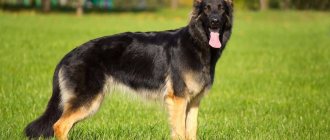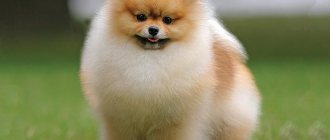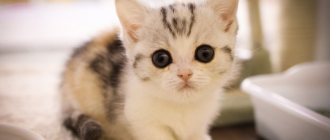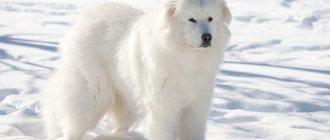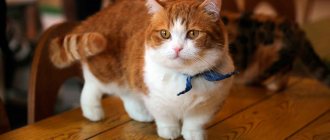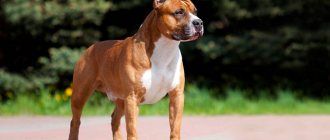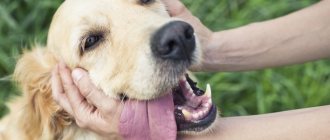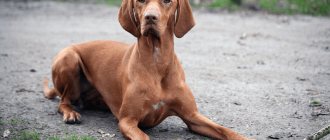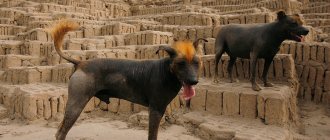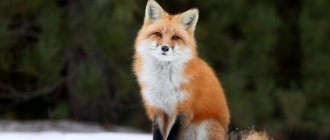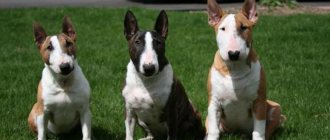Dogs and foxes are members of the canid family; both are curious, playful and love to explore their surroundings. In addition, some dogs share physical qualities with foxes, from their distinctive pointed ears to their red-golden fur. But, unlike dogs, foxes make terrible pets due to their wild nature and inability to train.
So, if you admire the mysterious elegance of foxes or their love of mischief, consider adopting one of the dog breeds below. Some of these breeds are little known outside of their native regions, while others have gained worldwide popularity. But regardless of their status, they are all delightful and unique.
Shiba Inu
In color and size, the Shiba Inu is most similar to foxes. This ancient breed of hunting dog is currently the most popular companion dog in Japan. Shiba Inus have been around since about 300 BC, although they were in danger of extinction immediately after World War II.
This is one of the most versatile breeds on our list, because the Shiba Inu will be happy in any home, be it a small apartment in a bustling city or a country house with a large backyard.
Cheerfulness, courage, self-confidence and good nature made Shiba Inu ideal pets. Shiba Inus love to run and play with their people, and they really suffer when separated for long periods of time. On the other hand, they are stubborn and sometimes aloof, so they are not the best dog for beginners. When properly trained, Shiba Inus get along well with children and other pets and are not hostile towards guests or strangers.
Varieties
Fox-like dogs come in different sizes: large, medium and small. All of them have both common characteristics and purely individual ones.
Collie
Long-haired collies reach a height of 60 cm and a weight of 30 kg. With such parameters, they are distinguished by grace and harmonious physique. In the past, animals were used as shepherds or working dogs, but now they are considered decorative.
The resemblance to a fox is enhanced by its elongated head, almond-shaped eyes, as well as a fluffy collar and tail. Thanks to the dense undercoat, the collie's coat is thick, the color is mainly sable, with shades of yellow, red and light golden tones.
They also resemble a cunning fox in their intelligence. Scottish Shepherds are unpretentious in care, but they are distinguished by their endurance and calm character.
They treat children with special attention and affection, being amazing nannies.
Samoyed
One of the most ancient breeds that lives in the north. Representatives of the breed served as sled dogs, as well as hunting and guard dogs. They can weigh up to 25 kg, and the height of an adult dog is up to 57 cm. The Samoyed is characterized by its great similarity to a white fox, not only by its strong, somewhat elongated build and coat color. They have a similar head shape - a wedge-shaped, slightly elongated muzzle, small triangular erect ears and slightly slanted eyes.
In addition, they are similar in the structure of their coat; in both animals it is two-layered, with a dense white or cream collar. Although the Samoyed's character is quite stubborn and independent, it can be easily corrected with proper upbringing and attention from the owner.
The breed is not at all characterized by aggression; they are extremely friendly and patient with children.
Norwegian Elkhound
It belongs to ancient hunting breeds and is characterized by its similarity to the silver fox. The dog's ears are triangular, straight, and its fur shimmers in shiny black and gray shades. Despite its endurance and northern temperament, the Elkhound has a gentle character. He is distinguished by his friendliness, intelligence and good attitude towards children . The negative aspects of the breed include excessive independence and the desire to dominate, as well as aggression towards other animals.
Representatives of this breed require training and socialization, otherwise they will become uncontrollable.
Shiba Inu
A Japanese hunting breed that was used for catching small game. Today, the dog has turned into a friendly companion and family pet, having lost its original purpose. Shiba Inus belong to medium-sized breeds; they can reach a height of 41 cm and weigh up to 12 kg. The dogs are playful and energetic, but unpretentious in their maintenance. By its nature, the animal is quite self-confident, and this feature can become a problem for an inexperienced or too soft owner.
To get obedience and respect from a dog, you need to give it a lot of time and attention.
Keeshond
The dog belongs to the Spitz variety. Previously, she was kept as a guard, but now she is acquired as a companion. The maximum height of the animal reaches 45 cm. According to external data, the Keeshond resembles a silver fox. The head is wedge-shaped with a slightly elongated, rectangular muzzle.
Alaskan Klee Kai
The Alaskan Klee Kai was bred in the 1970s to create a smaller version of the Siberian Husky . In 1988, the breed received recognition from most kennel clubs. These dogs are available in many colors, including black and white, gray and white, tan and white, and all-white. The red and white Alaskan Klee Kai is rare and closely resembles the red fox.
The Alaskan Klee Kai is a suitable pet for active people as these dogs have high energy levels and a high need for exercise.
Inexperienced dog owners may find this very playful breed challenging, but with constant training, the Alaskan Klee Kai can become the sweetest and most affectionate pet. He is usually friendly, but can be aloof and wary of strangers.
Slugi and Saluki
Incredibly fast Arabian greyhound from North Africa. Outwardly, Slugi resembles an Azawakh: the same tall, lean, long-legged. Colors are shades of red, from light sand to reddish.
The slug's fur is so smooth, thin and short that it is almost invisible.
In Russia, purebred Slugs are rare. The only nursery operates in St. Petersburg.
Shorthaired Salukis.
Due to their external similarity and consonant names, the Slugi is sometimes confused with another Arabian greyhound, the short-haired Saluki. But DNA studies have proven that these are two separate breeds.
Finnish Spitz
The Finnish Spitz comes from the “land of a thousand lakes.” This is the most popular dog breed in Finland. There they specialize in hunting birds, which they fascinate with their slowly wagging tails. They inform the owner about discovered prey using “yodeling” ( up to 160 barks per minute ).
The Finnish Spitz is related to other Nordic Spitz breeds such as the Greenland dog, the Chow Chow and even the tiny Pomeranian.
The Finnish Spitz is a medium-sized dog that belongs to the non-sporting group. It has a square build, red fur, and small, erect ears that give it a fox-like appearance. But unlike the shy fox, the Finnish Spitz is sociable and friendly . These dogs are incredibly loving, lively and playful, making them ideal pets for families with children. The Finnish Spitz is inclined to protect its owners; it avoids strangers.
Other breeds similar to foxes
Dog with short legs and big ears: list of breeds
There are other breeds that resemble red-haired forest dwellers:
- Spitz (Finnish, Pomeranian and German);
- Schipperke;
- Norwegian Elkhound;
- Welsh Corgi.
Schipperke
The black fox dog of the Schipperke breed was bred in Belgium and was originally used as a herding dog and for hunting rodents in barns and shops. These small shepherd dogs were considered good watchdogs. Now it is more of an ornamental breed.
Schipperke
The dogs are small, weighing no more than 9 kg. Height at the withers is from 28 to 32 cm. The color is exclusively black, the undercoat is thick, the guard hair is hard. The muzzle resembles that of a shepherd and a fox at the same time, the eyes are dark. The back is straight and strong, the paws resemble those of a cat with tightly pressed toes, the tail can be curled into a “donut” or hang down.
Schipperkes are not sofa decorations; they are active and inquisitive pets. The owner must be a partner in all games. Such dogs are not suitable for very young children; they will not allow themselves to be “squeezed.” They are also not suitable for the role of a nanny.
The owner must be very experienced; the Schipperke will more than once try to take the place of leader in the “pack”. At the same time, Schipperkes perfectly master even a complex training course. The Schipper just needs exercise, otherwise the dog will conflict with other pets, bully other dogs on a walk and attack guests. The dog needs to be constantly occupied, otherwise it will actively participate in the owner’s affairs.
Note! An ill-mannered pet can show aggression towards the owner and his family.
Norwegian Elkhound
One of the symbols of Norway, the Elkhound is not quite a fox dog. Its other name is moose husky, so representatives of this breed are more like wolves. The color contains different shades of gray. The tips of the hairs are always dark.
The breed is ancient; the remains of Elkhounds have been found in Viking graves. Such dogs were used to hunt big game: moose, wolves, lynxes, bears. The character of Elkhounds is truly canine: they are loyal, friendly and affectionate pets with children. The Elkhound is a good watchdog, distrustful of strangers.
But there are also disadvantages. Dogs are noisy, without training they can be aggressive towards other animals and strive to control their owner. They often make independent decisions. Suitable exclusively for experienced and active owners.
Elkhounds are medium in size, weighing on average 22-25 kg, 49 cm is the average height of an Elkhound at the withers.
Norwegian Elkhound
Pomeranian Spitz
Another small red dog that looks like a fox is the Pomeranian Spitz. These pets are very small, weighing up to 2 kg and height at the withers up to 22 cm. At the same time, their fearlessness does not correspond to their size; fluffy “oranges” will protect their owner to the last.
It takes a lot of time to care for fluffy red fur. Despite the fact that the dogs are decorative, they will not serve as decoration for the sofa. Pomeranians are constantly on the move and love active games and long walks. The Pomeranian Spitz does not have enough patience for small children, so if you have them, it is better not to get such a dog.
Note! A fox dog can easily train a weak-willed owner as needed. Therefore, Pomeranians are recommended for experienced dog breeders.
Pomeranian Spitz Filbert Mitch Boniface (Filka) – champion of Russia
Little German Spitz
The Small German Spitz is larger than the Pomeranian, reaching 28 cm at the withers. Average weight is 4-6 kg. During the molting period, the fluffy long coat needs to be constantly combed, at least once a day. The color can be different, including fox-red. The muzzle is pointed, the eyes and nose are dark, the ears are erect, the tail is ringed.
They are active and love to walk, but in bad weather they will be satisfied with the cat litter box. Most dog handlers do not classify these dogs as a separate breed, believing that they are one and the same with Pomeranians. But there are differences not only in size, but also in color, coat and tail shape.
Small German Spitz
Finnish Spitz are the most stubborn foxes
The second name for the Finnish Spitz is Karelian-Finnish Laika. They are excellent hunters and watchdogs. Height reaches half a meter at the withers. Average weight – 11-13 kg.
The muzzle is very similar to a fox, the nose is dark, the eyes are slanted and brown. The ears are set high and pointed. The coat is hard, quite long, and only variations in red color are allowed:
- dark orange;
- reddish red;
- red and gold.
Like many huskies, they do not tolerate heat well. The coat requires little grooming.
Finnish Spitz
Finnish Spitz are playful, but flexible, and can become a good nanny for the owner's child. They are very active and without energy output they can damage things in the house. Due to their hunting purpose, these dogs bark very loudly and it is important to teach the animal from puppyhood not to make unnecessary noise.
Welsh Corgis are small but smart animals
Cartoon Welsh Corgis are one of the most fashionable breeds. This little shepherd is infinitely loyal to its owner and adores children, never showing aggression even towards the most annoying of them.
Corgis are playful and affectionate, and cannot easily tolerate their owner’s inattention. Due to short paws, there are problems with the spine. These dogs should not jump from heights or walk a lot on stairs. Ideally, you need an orthopedic bedding; a Welsh Corgi cannot sleep on something that is too soft. Weight reaches 13 kg, height – 30 cm. Average life expectancy is 9-11 years.
Welsh Corgi
There are many breeds that resemble a fox: Akita and Shiba Inu, various Spitz, Corgi, Schipperke, Ecklehound. Despite their similar appearance, all these dogs have different personalities and maintenance requirements. Therefore, before getting such a pet, you need to study all the characteristics of the breed.
Basenji
Known as the “no-bark dog ,” the Basenji is an ancient breed that has been around for 5,000 years. Her images can be found on many Egyptian artifacts, Babylonian and Mesopotamian art. After the collapse of these mighty civilizations, the Basenji returned to the wild until their hunting skills were reclaimed by African tribes living along the Nile and Congo rivers. Genetically, Basenjis remain the same as when they were first presented to the pharaohs as a gift. In the shape of their muzzle and ears they are very similar to foxes, although they cannot boast of thick fur.
These dogs are incredibly vocal and will howl until they have your full attention. Their voice is a unique sound, described as being similar to a yodel .
Basenjis are independent and aloof animals, but this does not affect their love for family. They are incredibly clean by nature and love to groom themselves, just like cats. Basenjis require tons of both physical and mental stimulation, becoming destructive when they get bored. Their high energy and sharp mind often get them into trouble.
Rules of care
Keeping fox-like dogs does not require much effort or expense. Their dense “coat” repels water and dirt. Animals are also characterized by cleanliness; they themselves are able to maintain the cleanliness of their fur, and in addition, they try not to get dirty. Grooming involves brushing with a stiff brush, the frequency depending on the length of the coat. For breeds with shorter hair, once a week is enough, while dogs with long hair should be brushed approximately once every 2-3 days.
If tangles have formed in the wool, they need to be carefully combed out. During shedding, the procedure should be carried out more often, since the densely pubescent undercoat sheds quite heavily, ideally once a week. Dogs are bathed rarely or when they are heavily soiled, using special shampoos. It is better to leave your dog's haircut to a professional. In terms of hygiene, you need to trim the hair between the toe pads and in the lower area of the tail.
Dogs' ears, eyes and teeth should be examined regularly: the ears are cleaned with a damp swab as they become dirty, and special toothbrushes and pastes are used to clean the teeth about 3-4 times a week. The animal's paws must be examined after each walk to avoid damage. Nails are trimmed approximately once a month.
Thick fur provides a good habitat for parasites, especially ticks. After each return from a walk, the coat is inspected for their presence. It is necessary to undergo regular veterinary examinations, vaccinations and anthelmintic prophylaxis.
In the past, almost all fox-like dogs were shepherds or hunters, so they love active pastime, long walks and physical activity. Due to their waywardness and too independent nature, animals simply need training and socialization. The classes will not be too difficult, since dogs are very smart and have a fairly developed intellect, but their stubbornness can become an obstacle.
Here you need to find the right approach to your pet. Such dogs need a confident owner with a strong character who can show his leadership. Otherwise, the animal will take on this role, and it will be impossible to control it.
Longhaired Chihuahua
These miniature fluffy dogs are the smallest breed in existence. They appeared in Mexico in 1850. These dogs are available in almost all colors, but the long-haired red Chihuahua looks most like a dwarf fox.
Chihuahuas require minimal exercise and grooming, making them one of the most low-maintenance dogs. This is a good choice for older people .
Chihuahuas are eccentric, intelligent and incredibly loyal. They love to play with toys and be around family members, and their small size does not prevent them from fiercely protecting the people they love. It is worth noting that this breed is best suited for warm climates.
Sanshu
The new breed is not yet two centuries old, and although it resembles an Akita, it is believed that its ancestors were Chow Chows. Sanshu has an unusual structure of the skull and muzzle, a strong neck, developed muscles and powerful paws. An adult dog weighs about 25 kg, and in good conditions it is a real long-liver - up to 17 years.
Photo: zooclub.ru
Small dog breeds: names and photos (catalog)
Japanese Spitz
The breed likely originated from a mix of a white German Spitz and a white Keeshond from Canada that were imported to Japan around the 1920s . These beautiful dogs bear a striking resemblance to arctic foxes; they feel at home both in a small apartment and in a spacious country house.
The Japanese Spitz is always up for an adventure, whether it's a run on the beach, a hike in the forest, or a long car ride.
Japanese Spitz are intelligent, friendly, loyal and loving pets. They learn very quickly and often smile , especially during fun walks and active games. These are one of the most active and playful pets.
Story
Throughout its existence, the main purpose of the dachshund was hunting. It is believed that modern representatives descended from ancient hounds. Short dogs, considered a waste among their relatives, became the ancestors of dachshunds.
At first there were only two species - dogs for underground hunting with bowed legs and hounds with coarse hair. The growing popularity of dogs gave impetus to the breeding of other species that differed from each other in their coat type.
The first attempts to create dogs with a hard coat were unsuccessful. Only towards the end of the 19th century. managed to achieve the desired result. Pinschers, terriers, and schnauzers took part in the selection. At the same time, the first standard appeared.
In Russia, the breed was not in demand for a long time. It is known that A.P. Chekhov and actress N.E. Ermolova were admirers of these dogs. Dachshunds became widespread in the middle of the last century. Now the breed is popular both for its working qualities and for its individual, interesting character.
Pembroke Welsh Corgi
The Pembroke Welsh Corgi is one of the most popular herding dog breeds, with roots dating back to 1107 AD. The Pembroke Welsh Corgi is a separate breed from the Cardigan Welsh Corgi, although they are similar in appearance. However, both are very similar to short-legged foxes.
First introduced to Wales by Flemish master weavers, the Pembroke Welsh Corgi is best known as the beloved pet of Queen Elizabeth II .
They stand about 30 cm tall at the shoulders and weigh up to 13.6 kg, but such tiny sizes often mislead people. The Pembroke Welsh Corgi is extremely hardworking and resilient, and will happily join you on long walks. This is the epitome of a big dog in a small package. They are smart, friendly, loyal and empathetic, but also independent.
Andalusian maneto
Spanish primitive hunting dog. Outwardly similar to its ancestors, the Andalusian Podengo, only the limbs are much shorter.
Height at the withers is 30 – 35 cm. The coat is thick and close-fitting. Colors – all shades of cinnamon, white. In Spain, Andalusian maneto are kept by hunters and farmers, but can also be found in cities. The breed is not registered in the FCI, although it is under consideration by the Royal Canine Society of Spain.
Long, short-legged dogs, regardless of breed, are well suited for home keeping. However, they have different temperaments, levels of mobility, and learning ability, so each needs its own approach.
Schipperke
Schipperki are actually much smaller than they seem - only up to 33 cm in height and up to 7.3 kg in weight. These small dogs started out in Belgium as hard-working ship's dogs , bred to catch rats and look after valuable cargo.
These dogs hunted in a distinctive cat style and were popular among ship crews, earning them the Flemish name "schipperke" or "little captain".
Schipperkes are fearless, loyal and make excellent guard dogs. However, these beautiful pets can be quite independent and mischievous, so plenty of activity and training is needed to meet their needs.
Fat Pug doesn't go well together
Strong, compact, pugs look like aliens, as noted in the comedy “Men in Black”. These good-natured short-haired hulks are always in a great mood, and dark, bulging eyes on a round head with folds serenely look at the world.
Loading …
The only thing that can spoil a good mood is being forced to go on a diet, which little gluttons can hardly tolerate. Pugs are excellent companions: calm, non-aggressive, silent.
- Height: 24-36 cm.
- Weight: 7-10 kg.
- Color: Pure black, beige or fawn colors have a dark mask.
- Price: 15-30 thousand rubles.
Korean Jindo
These natives of the South Korean island of Chingo in Korea are very athletic and hardy. They have been kept by islanders as hunters and companions for thousands of years, and were even given pride of place at the opening ceremony of the 1988 Olympic Games in Seoul.
These powerfully built dogs are available in almost any color: white, fawn, red and white, tan, light fawn, black, black and tan, gray and brindle. The Korean Chindo, with its red and white coat, is very similar to Asian red foxes. What they also have in common is a thick double coat, which helps them keep warm in cold winters.
Korean Jindos tend to be quite assertive, which can cause trouble for owners, but they enjoy spending time with their family. It is also worth considering that these are territorial dogs that do not tolerate other pets on their territory.
They require regular exercise or at least 30 minutes of brisk walks. With insufficient energy expenditure, these dogs can become stubborn. On the other hand, Korean Jindos are very smart, so they quickly learn new tricks.
Basic colors
The main colors of fox-type Pomeranians include:
- Black
- Black and tan
- White
- Zone gray
- Brown
- Cream
- Ginger
- Sable
- Two-color
NOTE!
With any single-color colors, white spots and even just inclusions of white hairs are unacceptable.
As for white and black colors, they should be as pure and bright as possible.
Icelandic Sheepdog
As the name suggests, these dogs are native to Iceland. They began their journey when Iceland was first settled by Vikings over a thousand years ago . Icelandic Shepherds helped herd sheep, guard livestock, and search for stray animals.
These beautiful herding dogs are the ancestor of the Shetland Sheepdog (Sheltie) and Welsh Corgi.
Icelandic Sheepdogs come in long-haired and short-haired varieties; both varieties have a narrow fox-like face, erect triangular ears, and red fur with a brown back and white underparts. They are slightly larger than the average fox : weight up to 14 kg, shoulder height up to 46 cm.
This is a very active dog that needs intense daily exercise and walks. Icelandic Shepherds are quite friendly with other pets and strangers, but they need to be socialized at an early age . This breed suffers from separation anxiety and should not be left alone for long periods of time. Icelandic Shepherds love to play and learn new tricks.
Puppy price and tips on how to choose
Experienced dog breeders advise purchasing puppies at the age of two months. Babies no longer need breastfeeding or constant maternal care. They have received the required vaccinations.
When choosing a future pet, you should definitely pay attention to:
- on the puppy’s appearance (clean ears, eyes, absence of an umbilical hernia);
- on the mother’s appearance (an unhealthy-looking and unkempt animal is unlikely to have good offspring);
- on the puppy’s behavior (it is better to give preference to an active and active baby);
- on the conditions of keeping animals.
Several factors influence the cost of a puppy. Puppies sold at markets are usually inexpensive. But going to this place for a dachshund, there is a big risk of buying a pig in a poke. There is no guarantee that the animal is clean, meets the standard, or has a balanced psyche.
The price of a puppy from a kennel starts from 10 thousand rubles. The better the pedigree and the more titled the parents, the higher the cost.
Canaan dog
Canaan dogs reach 61 cm in height and weigh up to 25 kg. Their lean build, bushy tail, almond-shaped eyes and alert, pointed ears give them a distinct fox-like appearance.
Although no one knows how old the Canaanite breed is, the earliest images of it adorn tombs that date back almost 4,000 years.
Initially, Canaanite dogs helped the Israelites herd and guard livestock. When the Romans destroyed Jerusalem and dispersed the Israelites in 70 AD, stray dogs fled to the Negev Desert, where they lived until the 20th century. After the founding of the State of Israel, security was required for settlements, and service dogs were required for the army. Dog trainer Dr. Rudolfina Menzel proposed training semi-wild Canaan dogs. She argued that their ability to survive in the unforgiving desert conditions proved that they were suitable for difficult jobs.
To everyone's surprise, Canaan dogs turned out to be very intelligent and easily trained animals, despite their wild roots. They worked as service dogs, messengers and mine detectors, and after World War II they became guide dogs for the blind. Canaan dogs are confident and alert, and continue to make excellent guard dogs and service dogs.
Other types
In the canine literature, types of dachshunds are distinguished depending on their size. In this case, the main parameters are taken into account:
During the selection process, 3 groups of animals emerged and were named:
Ordinary adult individuals are characterized by average sizes: height 0.2-0.27 m, body weight up to 9 kg, chest volume 35 cm. The dwarf type is somewhat smaller: height 0.14-0.21 m, weight 4-5.5 kg , chest girth 30-35 cm. Rabbit dachshunds belong to the category of mini pets. Their height at the withers does not exceed 0.15 m. Mature animals weigh approximately 3.5 kg. The chest reaches a volume of up to 30 cm.
Dogs of standard sizes have full hunting properties; small varieties were bred for decorative purposes. They do an excellent job as pets. Miniature dachshunds appeared on Russian territory at the end of the 20th century.
Volpino Italiano
Volpino Italianos are small Spitz-type dogs native to Italy. Despite their small size, they were originally kept as guard dogs. These Florentine Spitz are very energetic and playful . The Volpino Italiano's job used to be to warn large mastiffs about an intruder.
These decorative miniature white dogs are very similar to polar foxes; the white and red Volpino Italiano resemble miniature common foxes.
For some unfortunate reason, the Italian Volpino almost became extinct in 1965. At that time, there were only five representatives of the breed left. But efforts to protect them have been very successful, and in 2006 there were already about 2,000 individuals. However, the Volpino Italiano is still a rare breed of dog .
Most Florentine Spitz dogs are found in Italy, but they are also bred in Scandinavia, the UK and the USA. Currently, the breed is registered in most well-known kennel clubs.
Collie
These beautiful and graceful dogs are very reminiscent of the Sheltie. But despite such similarities, these are two completely different breeds. Once upon a time they were used as herding and service dogs, but today they have turned into decorative and exhibition animals.
The height of an adult reaches 65 centimeters, and the weight is 35 kilograms. The straight, elongated head of collies makes them visually similar to a fox. The harmonious body of representatives of this breed is covered with beautiful thick hair.
Scottish Shepherds are very unpretentious and hardy dogs. They have a flexible mind and are highly trainable. Collies make excellent shepherds, guide dogs and companions.
Akita Inu
According to ancient Japanese tradition, it is customary to give tiny Akita Inu figurines to newborns, since this breed symbolizes health, happiness and long life . The breed gained universal fame after the release of the film about Hachiko.
In the past, Akita Inu specialized in baiting wild boars, deer and bears. In those days they were called “matagi-ken”, which translated from Japanese means “large game hunting dog”.
As a pet, the Akita Inu can be unpredictable and difficult to train. These dogs are wary of strangers and are often intolerant of other animals. But they remain extremely loyal to family and live up to their reputation as guard dogs. Akita Inus thrive in human society and will do whatever it takes to keep those they love safe.
Paraguayan fox
This is one of the representatives of the genus of South American foxes, an inhabitant of the steppes of South America. It has quite large dimensions: height 40 cm, body length 65 cm, weight from 4 to 6.5 kg. The fox's back is reddish to black, with dark stripes down the middle. The top and sides of the head are red, the bottom of the head and white. The animal's ears are triangular in shape and red with white hair inside. The back, shoulders and sides of the street are gray. The hind legs are gray, on the sides with black spots below. The sides of the forelimbs are red. This fox was lucky in the variety of food on the continent. In addition to the main diet: rodents, insects, birds, the Paraguayan fox can feast on snails, scorpions, fish, crabs, possums or armadillos. Pregnancy in the species lasts almost two months. The offspring number from 3 to 6 cubs, which are looked after by both parents. At 2 months they are considered fully grown.
Keeshond
These are very cute and charming dogs that look like a fox. Two countries are considered the homeland of Keeshonds - Germany and Holland. Representatives of this breed belong to the Spitz group and descend from the turf dog that once lived in the territory of modern Europe.
These are very sociable, active and inquisitive creatures. They are absolutely not capricious and not aggressive towards people. Keeshonds perfectly combine independence and devotion to their owner. They are incredibly responsive, vigilant and, despite their touching appearance, have not lost their protective qualities.
Afghan fox
This fox is also a representative of the fox genus. Lives in the Middle East up to Afghanistan. The Afghan fox is not afraid of hot climates; it can be found both in the mountains and in the driest areas, for example in the Dead Sea.
This representative of the fox family cannot boast of large size and bright color, but her long tail with thick fur is equal in length to her body, and attracts attention to her external appearance. The height of foxes does not exceed 30 cm, and the body length ranges from 45 to 55 cm, with a weight of 1.5-3 kg
The animal has a small graceful head with a short and pointed muzzle, on which a black stripe extends symmetrically from the eyes to the upper lip. Nature, having awarded this fox with large ears, which serve not only as an organ of hearing, but also as a heat sink in hot weather, deprived it of the protective thick layer of hair that covers the paw pads of all types of desert foxes, protecting it from the hot sand.
In summer, the fox's fur is covered in an unremarkable steel color with a lightish stripe on the throat and belly. Depending on where they live, animals can be light brown or almost black. And in winter, the coat of the Afghan fox is colored rusty-brown, with a gray underfur and black guard hairs. It looks very velvety and lush. The diet of the Afghan fox is quite different from other species. In addition to insects and rodents, plant food plays an important role in her life. In “love” these foxes are fickle, and form a pair only during the mating season. The female plays a major role in caring for the offspring. The male can only perform the security function of the den. The pregnancy of a fox lasts about 2 months; compared to the common fox and even the corsac fox, which does not differ in size, the Afghan fox has low fertility. 1-3 cubs are born, rarely three.
This species is also listed in the Red Book.
